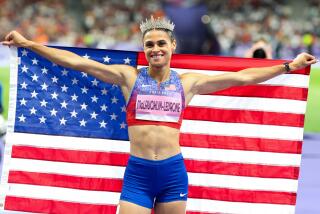Tarnished Images a Tough Sell
- Share via
There is one race in Athens that seemingly no track star can win.
It is the race for marketing stardom.
When Marion Jones finished eighth in a Sports Business Daily survey to select the 10 most-marketable U.S. Olympians -- far behind No. 1 Michael Phelps and six spots below softball pitcher Jennie Finch -- the message was as clear as the water at the Olympic Aquatic Center.
Even without testing positive for performance-enhancing substances, track and field stars are failing the litmus test for marketers because of questions raised by the BALCO doping scandal.
“I think so much of corporate America has washed its hands of track and field that it has opened up tremendous opportunities for swimmers and whoever might emerge, whoever might be this Olympic Games’ Rulon Gardner,” said David M. Carter, a Los Angeles-based sports marketing consultant.
Phelps, the swimmer pursuing Mark Spitz’s record of seven gold medals, is appearing in six national TV spots -- one for Visa, two for Argent Mortgage, and others for AT&T; Wireless, PowerBar and NBC, said his agent, Peter Carlisle.
Phelps also will earn a $1-million bonus from Speedo if he ties or breaks Spitz’s record.
“I think every swimmer and every athlete in any sport other than track and field has probably gained [because of the doping scandal],” said Carlisle, director of Olympic sports for Octagon. “Track and field athletes are generally sought after by marketers, but I think you’ve seen this year they’re looking outside track and field.
“Lay people, myself included, don’t understand the biochemistry of how these tests are conducted and what you can test for. That creates this big question mark that translates to risk for companies. There will be a residual stigma attached to track and field. Even if someone passes the drug test, the environment is still somewhat sullied.”
Finch, bolstered by her good looks, was second in the Sports Business Daily survey of more than 60 marketers, sponsorship consultants and media members. Swimmer Natalie Coughlin was third, followed by Gardner -- the Greco-Roman wrestler who has lost a toe to frostbite since upsetting Alexander Karelin in Sydney -- and gymnast Carly Patterson.
Sprinter Maurice Greene, at No. 6, and pole vaulter Stacy Dragila, at No. 9, were the only other track and field athletes besides Jones to make the top 10.
“I would say in general all the athletes have been getting fewer opportunities than what they would typically in past Olympics,” said agent Emanuel Hudson, who represents Greene in addition to hurdler Allen Johnson and sprinters Ato Boldon and Inger Miller.
“I think the market in general took a wait-and-see attitude this year. I don’t think it’s just the BALCO situation. I think it’s a combination. This is purely speculation, but I would think in general companies are spending less on Olympic marketing than in 2000, and if I’m correct, they’re obviously using less athletes as well.”
The possibility of terrorism is one risk, but a company wouldn’t be held responsible for being associated with the Olympics in the event of an attack in quite the way it would if an athlete tarnishes a brand by becoming a figure of scandal.
Jones, who remains under scrutiny despite denying allegations she has used performance-enhancing substances, might not gain any new endorsements in Athens, but Nike has not distanced itself from her.
“We have a Marion Jones print ad and a television ad,” Nike spokesman Scott Reames said. “She has never wavered in her statement that she is innocent and competes fairly, and we continue to support her.”
A television commercial featuring Jones sprinting away from a haunted house began airing Aug. 2.
Notably, however, footage of her boyfriend Tim Montgomery, a sprinter who failed to make the Olympic team and is facing a possible lifetime ban in the doping scandal, was left on the cutting-room floor, sources close to Nike said.
“We shoot a lot of different scenarios to have at our disposal,” Reames said.
Paul Swangard, managing director of the Warsaw Sports Marketing Center at the University of Oregon, said Nike needed to act carefully with the Jones issue. “I think they just have to make good decisions based on public perception and hope they have the pulse of what people are thinking,” Swangard said. “I guess they felt the general perception in Marion’s case wasn’t all gloom and doom and they still wanted to go forward with the ads they had developed.
“I think the benefit to companies like Nike is they have mitigated their risk by having so many athletes available to use. Like a good financial planner, they have a number of good investments. It’s easier for Nike versus a company that might have all this money on one athlete they hope will break through.”
Adidas, like Nike, has a stable of thousands of athletes to feature, including Greene, the American sprinter.
But the Adidas Olympic push, a continuation of its “Impossible Is Nothing,” campaign, focuses on Nadia Comaneci, Jesse Owens and Haile Gebrselassie, featuring two Olympians of the past along with the Ethiopian middle-distance runner.
The most prominent current Olympian is Kim Collins, the men’s 100-meter world champion from the tiny Caribbean nation of St. Kitts and Nevis. Collins is featured in the Jesse Owens ad.
“Kim Collins is a great ‘Impossible Is Nothing’ athlete, becoming a world champion from such a small island,” said Jan Runau, global PR director for Adidas.
The U.S. track scandal was not a factor in the company’s planning, Runau said.
“Doping is not a problem that is confined to track and field but is a general problem in sport. Corporate sponsors or companies cannot react on media speculation,” Runau said.
“We have a clear stance against doping and all our contracts have a clause allowing us to terminate a contract if one of our athletes is found guilty of being doped.”
Adidas has invoked such clauses twice recently, in the cases of British sprinter Dwain Chambers and German cyclist Jan Ullrich, Runau said.
With the price tag of a 30-second spot during NBC’s prime-time Olympic coverage at more than $700,000, advertisers must choose carefully when they select the faces that will be associated with their brand.
The risk of an athlete who endorses a company’s product becoming embroiled in a scandal is one reason Carter, the L.A. marketing consultant, suggested retired athletes are gaining appeal.
“When you factor in all the latest scandals in sports, even if you look at someone seemingly pristine like Lance Armstrong, there’s been so much debate. Think about Kobe Bryant, Marion Jones,” he said.
“I think we’re seeing companies use retired athletes like Muhammad Ali. Canon is using Steffi Graf now in addition to Andre Agassi. Corporations really want someone who has been around and is thought of favorably, not someone who wins three medals and then has them stripped.”
More to Read
Go beyond the scoreboard
Get the latest on L.A.'s teams in the daily Sports Report newsletter.
You may occasionally receive promotional content from the Los Angeles Times.






